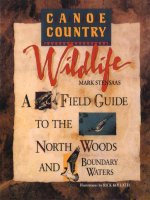canoe country wildlife a field guide to the north woods and boundary waters jul 1992
Bạn đang xem bản rút gọn của tài liệu. Xem và tải ngay bản đầy đủ của tài liệu tại đây (13.25 MB, 240 trang )
North Woods
and
Boundary Waters
Wildlif
A Field Guide to the
CANOE COUNTRY
This page intentionally left blank
CANOE
COUNTRY
A
Field
Guide
to the
North Woods
and
Boundary Waters
Mark Stensaas
Illustrations
by
Rick Kollath
University
of
Minnesota
Press
Minneapolis
•
London
M
IN
NE
SO
TA
M[ftj^-
Copyright
1993
by
Mark
Stensaas
Originally published
by
Pfeifer-Hamilton Publishers, 1993
First
University
of
Minnesota Press edition,
2004
All
rights reserved.
No
part
of
this publication
may be
reproduced,
stored
in a
retrieval system,
or
transmitted,
in any
form
or by any
means,
electronic,
mechanical, photocopying, recording,
or
otherwise, without
the
prior written permission
of the
publisher.
Published
by the
University
of
Minnesota Press
111
Third Avenue South, Suite
290
Minneapolis,
MN
55401-2520
http:/
/
www.upress.umn.edu
ISBN
0-8166-4529-9 (PB)
A
Cataloging-in-Publication record
for
this book
is
available
from
the
Library
of
Congress.
Printed
in the
United States
of
America
on
acid-free
paper
The
University
of
Minnesota
is an
equal-opportunity educator
and
employer.
12
11 10 09 08 07 06 05 04 10 9 8 7 6 5 4 3 2 1
Dedicated
to the one
Lord
God who
created this world
and
divinely designed
all its
fabulous
creatures
CONTENTS
Mammals
2
Bats
4
Black Bear
8
River
Otter
10
Pine Marten
13
Mink
15
Timber Wolf
19 Red
Squirrel
21
Northern Flying Squirrel
23
Eastern/Least Chipmunk
25
Beaver
30
Red-backed Vole
32
White-tailed Deer
35
Moose
Birds
42
Common Loon
47
Common Merganser
50
Mallard/Black Duck
54
Great Blue Heron
57
Spotted Sandpiper
60
Herring Gull
63
Turkey Vulture
66
Bald Eagle
70
Osprey
73
Broad-winged Hawk
76
Barred
Owl
79
Spruce Grouse
82
Ruffed
Grouse
85
Common Nighthawk
89
Belted
Kingfisher
91
Black-backed/
Three-toed
Woodpecker
95
Pileated Woodpecker
98
Gray
Jay
100
Common
Raven
103
Black-capped/
Boreal
Chickadee
106
Winter
Wren
108
Swainson's Thrush
110
Cedar Waxwing
112
Red-eyed
Vu-eo
115
Warblers
118
White-throated Sparrow
Fish
128
Walleye
131
Northern Pike
134
Lake
Trout
137
Smallmouth
Bass
Reptiles
and
Amphibians
144
Eastern Garter Snake
146
Snapping Turtle
148
Western Painted Turtle
150
Wood Frog
152
Green Frog
154
American Toad
Insects
and
Other
Invertebrates
160
Mayfly
162
White-tailed Dragonfly
165
Black-winged
Damselfly
167
Spittlebug (Froghopper)
169
Water Strider
171
Sawyer
Beetle
173
Whirligig Beede
175
Firefly
178
Luna Moth
180
Tiger Swallowtail
182
Mosquito
186
Blackfly
188
Deerfly/Horsefly
189
Bald-faced Hornet/
Yellowjacket
192
Fisher Spider
194
Wood Tick/Deer
Tick
197
Leech
199
Crayfish
Appendix
204
North Woods Primer
209
Table
of
Measurements
210
Keeping Track
of
Nature
212
Observation Checklist
214
Phenology Calendar
216
Daily Timetable
218
Sources
Ackno\vledgments
I'll never
forget
our
Saturday hikes.
I was in
high school
then,
and
birding friends were hard
to
come
by. My
"wandering
buddy" Chris Anderson,
his
uncle Jerry,
and I
would tramp
all
day
up,
over, across,
and
through
the
wild lands
of
central
Minnesota's
Hennepin
County,
stopping
to
check
out
whatever
caught
our
eye,
be it a
soaring Red-tailed Hawk,
a
deer skull,
or
a
mass
of
Leopard Frogs. Chris
and I
were going
to be
wildlife
biologists when
we
grew
up.
Eastman Nature
Center
naturalist
Cathie
Sandell became
our
mentor, showing
us the
ropes
of
being
an
outdoor educator.
Her
caring
influence
made
an
indelible mark
on my
life.
Time
spent
in the
woods with friends
and
naturalists
is
always
enjoyable
and is
often
a
great learning experience.
As
they shared their knowledge
of the
natural world, their exuber-
ant
curiosity rubbed
off
on me. A big
thanks
to
Chris Anderson,
"Uncle"
Jerry,
my
uncle
Ben
Thompson,
Dave Swanovich,
Kathy Sandell,
Ken
Gilbertson,
Don
Stauty, Jill Laughlin,
Tim
Conklin, Peter Olson,
Al
Hagen,
Dan
Burg,
Gary Irons,
Jon
Hinkel, Paul
Webster,
Chris Evavold, Bunter Knowles,
Kim
Eckert,
D.
Parker Buckstrom,
Jim
Winanen, Brett Nelson,
Tammy
Gravning,
and
Timo
Rova.
Much
of the
scientific
data
in
this book
was
gleaned
from
current scientific journals.
Without
the
years
of
field
work
and
lab
research
by
dedicated
and
perceptive ornithologists, mam-
malogists, herpetologists, ichthyologists, entomologists, ecolo-
gists, physiologists, ethologists, botanists, cell biologists, chemists
and
other scientists, this book would have been impossible.
My
scientific
reviewers thoroughly perused
the
text
to
make
sure
all the
facts
were
in
order
and
accurate. Thanks
to
Bunter
Knowles
and Cal
Harth
for
going over
the
entire manuscript
with
a
fine-toothed comb.
I'm
also indebted
to Dr. Don
Chris-
tian
for
reviewing
the
mammal section,
Pat
Collins
and Dr.
Gerald Niemi
who
checked
the
bird chapters,
and
Larry Weber
for
double checking
all the
insect
and
invertebrate
facts.
Rick
Kollath's excellent pen-and-ink illustrations beauti-
fully
bring
to
life
the
canoe country's critters
and add flavor to
the
text.
Pfeifer-Hamilton
Publishers
is
full
of
good
and
talented
people.
I'm not
sure this project would have been
completed
without Susan Gustafson's guidance, after-hours
effort,
and
encouragement
when
my
enthusiasm
was at a low
ebb. Patrick
Gross
also went above
and
beyond
in his
work
on the
manu-
script
to
make
the
book
a
success.
Joy Dey is a
talented graphic
artist
who
designed
the
marvelous layout
and
cover
for
this
book.
Editor Carol Kennedy somehow managed
to
make
sense
out of my
jumbled writing
and
transform
it
into readable text.
I'm
very
grateful
to my
publisher
Don
Tubesing
for
giving
me the
opportunity
to
write
Canoe
Country
Wildlife
and
also
for
publishing great books about
the
Arrowhead region
of
Minnesota, which
is
dear
to
many
of us.
And,
finally,
thanks
to my
parents
for
their support, allow-
ing
me the
freedom
to
take
the
"road
less
travelled."
"
C
1 "
Sparky
Mark Stensaas
September 1992
Introduction
The
Quetico-Superior wilderness,
a
16,000-square-mile canoe-
ists' paradise
of
interconnecting lakes, lies
at the
very heart
of
the
North American continent
and
straddles
the
United
States-
Canadian
border.
Declared
a
wilderness area
in
1964, Minnesota's Boundary
Waters
Canoe
Area Wilderness (BWCAW)
is the
largest U.S.
wilderness
east
of the
Rocky Mountains
and the
most heavily
used
portion
of the
entire U.S. wilderness system.
Its
twenty-
five
hundred lakes, many connected
to one
another
by
overland
portages, create
an
amazing 1200-mile labyrinth
of
mapped
canoe routes.
Ontario's
Quetico
Provincial Park
was
granted wilderness
status
and
protection
in
1973.
The
Quetico's
forests
are
also
laced
with
a
myriad
of
clear blue lakes
and
small rivers. Lake
Saganaga,
Knife
Lake, Basswood,
and Lac la
Croix
form
the
100-mile international border between
the
Boundary Waters
and
Quetico—between
the
United States
and
Canada.
The
Boundary Waters
and
Quetico
wilderness
is
home
to
hundreds
of
wildlife
species. Visited
in
their natural surround-
ings
on
their home
turf,
these
friendly
critters
add
immensely
to
the
adventure
of
traveling through this unspoiled natural
re-
treat.
Unfortunately, many people, even those
who
love
the
area
and
visit
it
regularly, know little about
the
creatures
who
live
there.
They
hurry across
the
portages
and
paddle
across
the
lakes
so
quickly that they miss
a
good share
of the
intrigue
and
the
beauty
of the
wildlife around them.
This friendly
field
guide
Canoe
Country
Wildlife
is a field
guide
to the
most commonly
encountered mammals, birds, reptiles, amphibians,
fish,
insects
and
other invertebrates native
to the
Boundary Waters Canoe
Area Wilderness
and the
Quetico
Provincial Park.
It is
designed
primarily
for
spring, summer,
and
fall
visitors,
be
they canoe
trippers,
day
paddlers, anglers, guides, lodge guests,
or
local
residents.
The joy of
wildlife
watching grows when
you get to
know
the
habits
and
understand
the
lifestyles
of
each creature that
you
meet.
But
when you're
out
there
how do you
correctly
identify
the
wildlife
that
you
see?
Or
notice their
habits?
Or
understand their
lifestyles?
Canoe
Country
Wildlife
helps
you
answer
these questions.
It
helps
you to see
more—and
to
understand what
you are
seeing.
The 75
species
of
wildlife
included
in
this book
are
those
you
are
most likely
to see or
hear
on
your canoe trip into
the
Boundary Waters
and
Quetico.
However, even
if
you're
a
most
observant
paddler,
you
won't
see
them
all on a
single trip.
And
because
this wilderness
is
home
to
many more species than
are
included
in
this book,
you may
encounter
a
number
of
crea-
tures
not
described here.
For
quick
reference,
complete check-
lists
of all
Boundary
Waters
and
Quetico
mammals, birds,
reptiles, amphibians,
and fish are
found
at the end of
their
respective
sections—not insects, though, there
are far too
many.
The
format
To
facilitate
easy
reference,
the
information
for
each species
is
presented
in a
consistent format.
Quick
identifiers—Accurate line drawings
and the
brief
de-
scriptions that accompany them will help
you
rapidly
identify
the
wildlife
you
see.
Natural
history—Information about
the
physical characteris-
tics,
habitat,
food
preferences,
and
daily activities
of
each
animal will help
you
know where, when,
and how you
might
encounter
it.
Tidbits—Fascinating little-known
facts
are
highlighted
in
sidebars.
Activities—The
"Sparky says" activities will help
you to
dis-
cover
on
your
own a
variety
of new and
interesting aspects
of
the
North
Woods
and the
wildlife
that inhabit
it.
Checklists—Species checklists
are
included
at the end of
each
section.
Worksheets—Observation worksheets
are
located
at the
back
of
the
book. You're welcome
to
reproduce these worksheets
for
use
on
your trips.
Style—In line with
the
informal
style
of
this guide, common
names
are
used
in the
headings
and in the
text.
Those
common
names
referring
to a
single
specific
species
are
capitalized, while
generic common names
are
left
in
lower case. Since common
names
vary regionally,
the
scientific Latin name
for
each species
is
also included.
While
all
facts
are
based
on the
latest scientific research,
the
text
has not
been cluttered with references. Full citations
for
specific
studies
and key
books
are
listed
for
your convenience
in
the
appendix.
Wildlife
watching tips
Watching
wildlife
in the
wilderness
is not
easy.
When
we
enter
the
wilderness,
we are the
strangers,
and
more
often
than not,
the
wildlife
end up
watching
us.
Great Gray Owls
can
hear
a
vole skittering through
its ice
tunnels under three
feet
of
snow.
Timber
Wolves
can
smell
a
Moose
300
yards upwind. Bald Eagles
can
spot
a
shallow-
swimming
fish one
mile distant.
With
creatures
of
such ability
watching
us,
it's
no
wonder
we
don't
encounter more animals
on our
canoe trips.
You
can, however, learn skills
to
increase
the
odds
of
your
wildlife-watching
success. Here
are a few
tips
for
making your-
self
a
gracious guest
in the
wildlife's home territory
and for
seeing
more
of
what's around
you
when you're
out
there.
Gather
information about
the
lifestyle
of the
critters
you
expect
to
encounter. When
are
they
active?
What
do
they
eat?
Where
are
they
found?
This
book will give
you a
good start.
Blend
in, be
quiet
and sit
still. Wear clothing
that
helps
you
blend into
the
surroundings. Stalk
the
animal
by
staying down-
wind
and
moving slowly
and
silently.
Follow
the
signs.
Look
for
tracks. Study
the
markings
and
interpret
the
story they tell. Start where it's easy—on
the
shoreline
or
sand.
After
you've
practiced,
look
for
tracks
in the
woods where they're harder
to
discover. Examine
the
drop-
pings
of
insects, birds,
and
mammals
for
evidence
of
their
presence
and
their eating habits. Look
for
patches
of
fur,
leftovers
from
meals, nibble marks
on
bark—even skeletons
of
the
deceased—-to discover
the
animals' homes. These
are
clues
to how the
animals live.
Watch
the
clock
and the
seasons.
Like humans, animals
de-
velop
a
predictable rhythm
to
their days—regular times
for
eating, singing, exercising, playing,
and
resting.
The
seasonal
cycles
also occur regularly
and
predictably
from
year
to
year.
Pay
attention
to the
timing
of
what
you
observe.
Then
set
your
wildlife
watching schedule
in
line with what
you
have learned.
Attract
the
wildlife
you
want
to
observe. Most animals
are
just
as
curious about
you as you are
about them.
So
look
for
ways
to
attract them. Clench your teeth
and
repeat
the
word "pishhh"
four
or
five
times.
This
sound drives some birds crazy with
curiosity. Make
a
high-pitched squeak
by
kissing
a
knuckle
on
the
back
of
your hand.
This
sound resembles
the
cries
of an
animal
in
trouble
and
will attract those
in
search
of a
free
meal.
Mimic
the
sounds that
you
hear—songs
of the
birds, calls
of
the
animals. Bait your observation area with smells
and
food
that
will attract
specific
species.
Enhance
your
senses with
the aid of
technology.
Use a
magni-
fying
glass
to
make
the
miniature world larger.
Use
binoculars
to
bring distant events closer.
Turn
on a
flashlight
or
headlamp
to
help yourself
see in the
dark. Strap
on a
snorkel
and
mask
to
discover
the
underwater world.
So
go
ahead
and
develop your
own
style
of
seeing—and
of
being—in
the
woods. Make yourself
at
home
in the
wilderness.
Sharpen
your skills
of
observation
and
your senses.
A
final
note
Although specifically developed
for the
Boundary Waters
and
Quetico
lands,
Canoe
Country
Wildlife
describes
the
most com-
mon
creatures
of the
North Woods—many
of
whose ranges
span
the
continent.
This
book will, therefore,
be
useful
from
Alaska
and
British Columbia
to
Quebec
and New
England,
as
well
as
around
the
upper Great Lakes. Bring
it
with
you on
journeys
to
Yosemite, Yellowstone,
Banff,
Algonquin Park,
the
Allagash,
or the
Adirondack Mountains—as well
as on
your
excursions
through Northern Wisconsin, Upper Michigan,
and
the
Boundary Waters
and
Quetico
wilderness.
Read
and
enjoy
the
essays.
Try out the
suggested activi-
ties—and experiment with some
of
your own.
Use the
check-
lists
to
record your observations
of the
wildlife
you
encounter.
Consult
the
seasonal calendar
to
check
out the
natural events
you're likely
to
witness.
Then
share with others what
you
learn
through your adventures.
Canoe
Country
Wildlife
is
designed
to be
used. Cram
it
into
your
trusty Duluth Pack
or
stash
it in
your backpack,
but
wherever
you
carry
it,
keep
it
handy
and use it! I
hope
it
will
make your
North
Country trips more enjoyable.
This page intentionally left blank
This page intentionally left blank
Mammals
Timber
Wilf
15
Eastern/Least Chipmunk
23
Red-backed
Vole
30
White-tailed Deer
32
Bats
2
Black
Bear
4
"RivV
Otter
8
tW~^arten
10
I^ink
13
Red
Squirrel
19
!?ofeiern
Flying
Squirrel
21
Beaver
25
Moose
35
CANOE
COUNTRY WILDLIFE
Bats
Order Chiroptera
U
nlike
flying
squirrels, which
can
only glide, bats
can
truly
fly.
A
bat's "wings," actually skin membranes, stretch
the
length
of the arm
between
four
very long
fingers and are
attached
to the
sides
of the
body
and
hind
legs.
The
thumbs
are
free,
and
hang
from
them.
Bats
can see but
rely heavily
on
sonar
for
navigation
and
location
of
prey.
Their
prey
is
chiefly
flying
insects—moths, beetles,
flies,
true bugs,
and
mosqui-
toes. Bats,
of
course,
are
nocturnal. People have many
false
beliefs
about bats. Contrary
to
their
bad
reputations, bats
do
not get
tangled
in
people's hair,
nor are all
bats rabid.
The
canoe country's seven species
of
bats
all
stay around
during
the
summer,
but
when
the
bugs
go, so do the
bats.
Silver-haired,
Red,
and
Hoary Bats, known
as
"tree bats,"
migrate
south
to
more "buggy" climes.
"Cave
bats" wait
out
the
winter
in the
comfortably numb state
of
hibernation.
These include
the
Northern Myotis, Little Brown
and Big
Brown
Bats,
and
Eastern Pipistrelle.
Flying
mammals
Color
varies:
brown,
black,
gray,
reddish
Often
seen
at
dusk
about
lake
margins
Echo
. . .
echo
. . .
echo
. . .
echo
Bats
are not
blind—they
do
have
eyes
and can see
well during
daylight,
but
they must lock into sonar
for
night navigation
and
hunting. Cruising
its
favorite
feeding haunts,
a bat
sends
out ten to
twenty high-pitched calls every second.
The
high-
frequency
sounds
(up to
98,000
cycles
per
second) bounce
off
objects
and
return
to the bat as
echoes. This process
is
known
as
echolocation.
When
it
receives
a
blip
on its
mental screen,
the bat
increases
the
sonar rate
to 250
calls
per
second
in
order
to fine-tune the
picture.
As the
details become clear,
a bat can
even
distinguish
a flying
beetle
from
a
soft-bodied moth.
Snatching
up to
three hundred insects
an
hour,
a bat can
eat
half
its
weight
in
insects
a
night. Contrary
to the
popular
image,
not all
prey
is
caught
by the
bat's gaping mouth.
A bat
scoops
most insects into
its
ballooned tail membrane
and
then
transfers
them
to its
mouth while
on the
wing.
A bat can
repeat
this awkward performance twice
in one
second.
2
MAMMALS
Wingspan
&
Flight
Characteristics
Color
Favorite
Food
Hunting
Times
Hunting
Pattern
Daytime
Roost
Solitary
or
Communal
Migrate/Hibernate
Winter
Home
Number
of
Young
Potpourri
Little
Brown
Bat
8-10
inches
low
zig-zag
flight
uniformly
glossy
brown
moths, beetles,
mosquitoes
late
dusk
caves,
buildings,
and
hollow trees
maternity colonies
of
several thousand
hibernates
caves
and
mines
Sept-May
1
young (rarely
2)
One
lived just over
30
years,
a
record
for
bats.
Big
Brown
Bat
12-14
inches
strong, steady
flight
uniformly
glossy
brown
true bugs
and
beedes
active
all
night
wooded clearings
caves,
buildings,
and
hollow trees
maternity colonies
hibernates
buildings
or
caves
where temps
are
just
above
freezing
2
young born
June/
early
July
Audible chattering
is
low-pitched radar
signals.
Northern
Myotis
10-12
inches
dark dull brown
variety
of
insects
dusk
and
dawn
over
trees
and
ponds
caves,
buildings,
and
hollow trees
maternity
colonies
of
up to 30
hibernates
migrates
south
to
hibernate
in
small
groups
1
young
Found
in
caves
on
Lake Superior's
North
Shore.
Silver-Haired
Bat
10-12
1/2
inches
slow
and low
long pelage, frosted
with
silvery
white
insects hatching
from
streams
early
in
evening
zig-zag
flight
over
streams
roosts singly
in
hollow trees
solitary
migrates
winters
as far
south
as
northeast Mexico
2
young born
June/early July
Returned home
after
being released
94
miles away!
Red
Bat
11-
13
inches
long pointy wings
bright
reddish/
orange
to
chestnut
moths,
beedes,
and
flies
early
in
evening
near
streams
and
woodlots
roosts
in
trees,
hangs
by one
foot
solitary
migrates
moves south
in
loose
groups
1-5,
usually
3-4
Summers
from
Canada
to
South
America.
Hoary
Bat
14-16
inches
long narrow wings
brown with silver
tips
moths, also beetles,
bugs,
and flies
active
all
night
wooded areas
roosts singly
in
tall
woody vegetation
solitary, except
in
migration
migrates
believed
to
winter
in
Mexico, sexes
migrate separately
2
young
in
late
May/early July
Most adults
in the
canoe country
are
females.
Sparky
says:
Humid,
still
summer
nights
with
a
full
moon
provide
the
best
times
to
observe
bats.
Sit on the
rocks
or
paddle
the
shore
quietly
just after
sunset.
The
mosquitoes
may be
swarm-
ing,
but
don't
curse
them;
remember
that
they
are
bat
chow.
Watch
the
bats.
How do
they
fly?
Direct?
Meandering?
Zigzagging?
How
high
above
the
water
do
they
fly? How
wide
is
their
wingspan?
Use the bat
chart
to
make
an
educated
guess
as to
which
kind
of bat
you're
watching.
Even
experts
need
a bat in the
hand
to
accurately
determine
its
species,
so
relax
and
have fun. Bring
a big flashlight to
spotlight
the
action.
I3at
guano
and
the
U.S. Army
Bat
guano (poop)
Is
har-
vested
(mined?) from
Texas
caves
for use as a
nitrogen-
rich
fertilizer.
The
U.S. Army
also
uses
guano.
Guanlne,
extracted
from
guano,
Is
combined
with
sulfuric
acid
to
form
nitroguanidine,
which
Is
used
as a
propellant
in
artillery
and
tank
ammuni-
tion.
3
Usually over water
over water and
CANOE
COUNTRY
WILDLIFE
Black
Bear
Ursus
americanus
Black
fur or
cinnamon,
blue,
and
brown
in
rare
instances
Adults
weigh
150 to 400
pounds
Often
seen around
campsights
Occasionally
seen
swimming
A
s
a
Boundary
Waters-Quetico
paddler
the
first
Black
Bear
you're likely
to
encounter will
be at the
campsite.
And
that bear will
not be
there
to see
you.
It
will
be
much more
interested
in
your trusty Duluth Pack
and the
powdered spa-
ghetti
sauce,
Jell-O
cheesecake mix,
and
peanut-M&M-raisin
gorp inside.
Your
first
face-to-face meeting with
a
150-to-400
pound
Black Bear
is
likely
to be
intimidating.
Razor-sharp claws
and
bone-crushing
jaws
that possess some mighty nasty looking
flesh-piercing
fangs
seem
to
indicate that
raw
human might
be
on the
menu
("mmmm,
chewy
on the
outside, crunchy
in the
center").
But the
mainly vegetarian Black
Bears
thrive
on
fruit,
nuts,
and
grass. Eating grubs, ants, bees, snakes, mice,
and
nestling birds hardly
qualifies
them
as
vicious carnivores.
An
average canoe country bear weighs between
250 and
325
pounds,
is
41/2
to 5
feet
long,
and
stands
2
tod
feet
tall
at
the
shoulder.
A
583-pound bruin established
the
Minnesota
record, while
a
Wisconsin hunter bagged
an
800-pound mon-
ster.
The
standard model
is
black with
a
white
throat
blotch,
but
Black Bears also come
in
blue, brown,
and
cinnamon
phases. Grizzly Bears
are not
found anywhere east
of the
Rocky
Mountains.
An
em-"bear"-assing
tale
This
em-"bear"-assing
tale
is
almost
un-"bear"-able
to
recount.
It
happened eight years ago,
and I can
"bear"-ly
remember
it. I,
an
assistant guide,
and
seven hardcore juvenile delinquents
from
Chicago camped
on a
lake along
the
Granite River route.
My
fellow
guide
and I sat up
late discussing tomorrow's itiner-
ary,
and
suddenly
we
heard
the
telltale snap
of
twigs, which
in
the
canoe country
can
mean only
one
thing.
. .
bear!
We
gathered
up
stones,
flipped
a
canoe
on its
side
to act as a
"bear"-
icade,
and
watched
the
show.
The
other guide
had
insisted
that
I was
hanging
the
food
pack
too
low,
but I had
countered that there
was no way a
bear
4
MAM M ALS
could reach
it.
This
one, however,
was a big
Black Bear.
Standing
on his
hind legs,
he
latched
his
claws into
the
faded
green canvas
and
yanked
it
clean
from
the
tree
as if
snatching
a
sock
off a
clothesline.
We
took bets
on
what would
be
eaten.
We
both lost.
That
bear
ate
everything, including
our
shorten-
ing.
Truly
an
undiscriminating
palate.
Take
the
proper precautions
by
hanging your food pack
high
from
a
limb
or
suspended between
two
trees. Keep
the
pack
at
least
10
feet
up and
away
from
the
trunk.
A
lazy option
is
to put
your pack under
an
overturned canoe with
a
stack
of
cooking pots
on
top. Leave
no
food
in
your tent.
To
drive
off
an
unwanted
furry
campsite visitor, yell,
shout,
bang pots,
and
throw rocks.
But if
this doesn't
work—and
it
often
won't
if
food
is
accessible—just
let the
bruin
go
about
his or her
business.
No use
getting yourself mauled over some chunky
peanut butter.
The big
snooze
I
have seen hundreds
of
bears
in my
brief lifetime. Unfortu-
nately,
99
percent
of
them have been feeding
at
dumps
or
engaging
in
other human-assisted food-gathering operations
(i.e. foraging
in
garbage cans
or at
bird feeders,
or
taking
roadside
handouts).
One
encounter with
a
bear
doing
bear things stands clear
in
my
memory.
One
Halloween
my
friends
and I
were paddling
down
the
Little Indian Sioux River just south
of
Devil's Cas-
cade.
I
looked across
the
wide cold river
and saw a
Black Bear
drinking
from
the
shore. "Bear!"
I
yelled.
The sow
angled
up
the
hillside over
the
golden aspen leaves.
We
followed. Under
the
upturned roots
of a
fallen
Quaking
Aspen
we
found
the
fresh
diggings
of a
bear den. From this evidence
we
assumed
we
had
seen
a
female. Sows need
the
comfort
of a
leaf-lined,
well-
protected
den to
give birth.
Male Black
Bears
tend
to
hibernate where they
fall,
so to
speak, with minimal shelter.
The
base
of a
tree serves
as
well
as
5
CANOE
COUNTRY
WILDLIFE
Eats
like
a
bird
Contrary
to
popular
belief,
Black
Bears
are not
blood-
thirsty
carnivores,
killing
other
mammals
to
satisfy
their
hunger.
Rather they
subsist
on
fruits,
berries,
insects, grass,
and
flowers.
Opportunistic
to the
end,
though,
a
bear
will
not
pass
up
a
nestful
of
young
birds,
an
old
deer
carcass,
or a
snake
slithering
across
its
path.
a
pile
of
brush.
I've
talked
to
people
who
have snowshoed righ
over
the top of a
hibernating male bear.
The
controversy over whether Black
Bears
are
true hiber-
nators
or not
seems
to be
inconsequential.
While
their body
temperature
and
pulse rate drop only slightly, bears
do not
drink,
feed,
urinate,
or
defecate during their six-month slum-
ber.
Now
that's
a
deep sleep.
A
half year without
food
requires
bears
to put on a
thick
blanket
of
fat
in the
fall.
They
travel
to
exploit abundance.
They
seek carbohydrate-rich blueberries,
chokecherries,
Wild
Sarsaparilla berries, hazelnuts,
and
acorns
in
order
to
accumulate
the
100-pound
layer
of
fat
needed
for a
comfy
cozy winter sleep.
Most bears
are
asleep
by
mid-November. They
cut
their
metabolic
rate
by
half
yet
maintain
an 88° F
body temperature,
which
is
within
12°
of
normal. Females awake
in
January just
long enough
to
give birth
to two or
three tiny 8-ounce cubs.
The
equivalent would
be
human mothers birthing 4-ounce
babies!
The sow
bear, usually,
falls
back
to
sleep.
The
tiny cubs
nurse
and
grow
but do not
hibernate.
It is
truly amazing
that
bears
can
survive
a
half year without
voiding body wastes. Urea,
a
substance that would quickly
poison
the
human body, breaks down
in the
sleeping bear
to
create protein that helps maintain muscle tissue. Bears actually
awaken
with more muscle than when they went
to
sleep.
Now
there's
a
great idea
for a
health
spa.
Join
up,
come
in to
slee
for
a
couple months,
and
leave with
a
well-toned body! Physi-
ologists have taken
a
keen interest
in
this phenomenon, since
the
voiding
of
wastes poses
one of the big
problems with
cryonics,
long-term human "hibernation"
by
freezing.
Bear
biology
is
crucial
to
current cholesterol research.
The
Black Bear's cholesterol rate
is two
times
that
of a
normal
human
but
they
suffer
no
hardening
of the
arteries
or
gall-
stones. Researchers found
that
bears produce
a
bile juice
that
dissolves
gallstones
in
human test patients.
Mid-April
finds
most
of the
canoe country's bears awake
and
stretching
in the
spring
air.
Some will have lost
a
full
30
6
MAMMALS
percent
of
their body
weight—their
100-pound
fat
reserves.
Mothers
and
their cubs hang
out at the
bases
of
large
White
Pines, whose ridge-barked trunks
offer
an
easy climb
to
safety
for
tiny cubs. Food
is
scarce until
the
green-up, which begins
about
May
1.
Aspen
and
willow catkins provide early spring
appetizers
for the
bears, holding them over until they
can
graze
on
lush spring grass.
The
fattening process starts
all
over again.
Sparky says: Pick berries
and
make
a
wilderness
pie.
Enjoy
the
canoe country's brief abundance
of
lush, plump blueberries, raspberries,
juneberries,
and
chokecherries, just
as the
bears
do
each summer.
Wild
blueberries
put
pulpy
domestic varieties
to
shame,
and a pie of
your
own
hand-
picked berries
is a
special treat. Look
for
charred standing snags
that signal recent burns,
for
here raspberry
and
blueberry
plants thrive.
The
Fourth
of
July marks
the
time
to
start
looking
for
early ripe blueberries,
but
they will still
be
"pickable"
through early August.
Fill
a
couple pots
or
empty water bottles
with berries
to
take back
to
your campsite. Relish them
in
biscuits
and
pancakes,
a
cobbler,
or a
pie.
Here's
an
easy camp
recipe
for
blueberry bannock:
Mix
2
cups
flour
3
tsp. baking powder
!/2
tsp. salt
6
tbsp. shortening/margarine
4
tbsp. powdered milk
Add
1 cup
blueberries
!/3
cup
water
Shape
into
1-inch-thick
cakes. Dust with
flour
before
placing
in
a
hot, greased
fry
pan.
Turn
when bottom
is
golden
and
crusty. Check cakes
for
doneness
by
inserting
a
wood splinter.
If
it
comes
out
clean, they're ready
to be
smothered
in
butter
and
slowly savored.
7
CANOE
COUNTRY
WILDLIFE
River
Otter
Lutra
canadensis
Large
aquatic
weasel
Up
to 4
feet
long
from nose
to
tail
Often
seen
in
groups,
only
their
heads
sticking
out of the
water
Snorting,
gurgling,
and
churring
noises
T
he
River
Otter
is the
canoe country's second-largest mem-
ber
of the
weasel
family,
smaller only than
the
rare
and
much maligned Wolverine.
It may
surprise some
to
learn that
not
only
are
River
Otters
and
Wolverines weasels
but so
also
are
Striped Skunks, Badgers, Mink, Fishers,
and
Pine Martens.
How
large
are
River Otters?
A big
Alaskan male
may be 5
feet
long
from
sniffing
nose
to
twitching tail
and top 30
pounds. Most
do not
exceed
4
feet
and 20
pounds.
Their
true
size
comes
as a
shock
to
many paddlers,
who
usually encounter
otters
as
just curious heads,
sniffing,
snorting, grunting, purr-
ing,
and
growling
from
the
water.
What
you see is
just
the tip
of
the
iceberg—or
literally,
of the
otter.
Campers commonly
see
River
Otter
families
swimming
in
lakes during
the
summer.
Their
pelage
is
lustrous brown
with
a
silvery
wash
on the
muzzle
and
throat.
Slip
sliding
away
River
Otters
are
first-class boreal buffoons. Much
has
been
written about whether
or not
animals play,
and
some behavior-
ists
remain skeptical,
but it
would
be
hard
to
watch
a
group
of
otters repeatedly sliding down
a
snowy bank
on
their bellies
and not
believe
that
they were having
a
darn good time.
The
otter's method
of
winter locomotion incorporates
"the
slide," since simple bounding
is too
boring
and
slow.
An
otter
runs only long enough
to get up
speed
to fling its
torpedo-
shaped body into
a
graceful
glissade.
It
lopes-and-slides,
lopes-
and-slides,
lopes-and-slides,
in
snow
and on
ice.
One
naturalist
measured
the
slide
of an
otter
on
light snow over smooth
ice at
27
feet!
It
always amazes
me to see
their tracks
so far
from
any
apparent open water. Otters
may
keep ice-holes open
in
frozen
lakes
through repeated
use.
Gaps
of air
between
the
bottom
of
the
lake
ice and the
lowering lake level allow otters
to
surface
for
air
beneath thick
ice.
8









